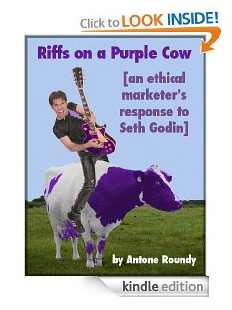When you purchase through links on our site, we may earn an affiliate commission (details)
“Spend Money. Live Better.”
by Antone Roundy | Add Your Comments | Advertising, Copywriting
Walmart's customers don't seem to be getting the message.
And Walmart isn't about to complain.
Last month, Roger Dooley at Neuromarketing wrote about some research that suggests that Walmart's slogan "Save money. Live better." may inspire customers to spend more:
The experiment divided subjects into two groups. Half were exposed to brand names associated with saving money, like Walmart, Dollar General, Sears, Ross, etc. The other half were exposed to the slogans for those retailers, like Sears' current motto, "The Good Life at a Great Price. Guaranteed." When asked to visualize a shopping trip and describe how much money would be spent, the brand-exposed group spent an average of $94 vs. the slogan group, who spent just about twice as much: $184.
A second study found that exposing consumers to a "savings" message caused them to spend more than when they saw a "luxury" message.
When I see an ad telling me how I can "save 50%" on something I don't want, my reaction is usually along the lines of "oh yeah, I know a way to save 100%" (and I'm not talking about a five finger discount).
On the other hand, when the product is something I want, the message sounds a lot better. So it's not surprising that a "save by spending" slogan would get people in the mood to open their wallets more freely.
And there are a lot of people who just plain enjoy spending, even on things that don't particularly want. For them, the "save by spending" message is convenient justification for indulging their guilty pleasures.
The difference in response between the savings message and the luxury message was interesting. As one of the commenters on Roger's blog mentioned, the effect might not be the same for luxury brands vs. discount brands.
But who knows. I'm sure it depends as much on the consumer as on the product. People who usually can't afford luxury products might occasionally jump at an offer they felt was getting them a prestige product for less.
And while it's we'll known that raising the price of luxury items often increases sales, it would be interesting to know whether it's the price that makes the difference, or the perception of the price. If nobody knows you've found a place that's selling luxury for less, will the lower price really decrease your spending?
Getting back to the research though -- I'm reminded of sale announcements that say things like "Save 50% off ..." The wording always seemed wrong to me (I'll admit it, I'm something of a grammar Nazi). "Save 50%" and "50% off" are both fine, as is "take 50% off". But shouldn't it be "Save 50% on ..."?
I'm guessing the difference has been tested, and "save 50% off" won. Which makes sense, even if it irritates me.
Anyway, the big point is that a savings message leads to more spending. So how do you use a savings message without cutting your prices? Here area a few ideas:
- Compare your price to what someone else is selling a comparable, but more expensive product for. "Save 25% compared to Brand X Widgets."
- Create a bundle deal and compare its price to the individual prices of the parts.
- If you don't have multiple products to bundle together, team up with someone who has a complementary product, create a bundle together, and split the profits.
- ...or split your product into multiple parts, sell the pieces as prices that total more than the complete product, and compare to the individual total price.




